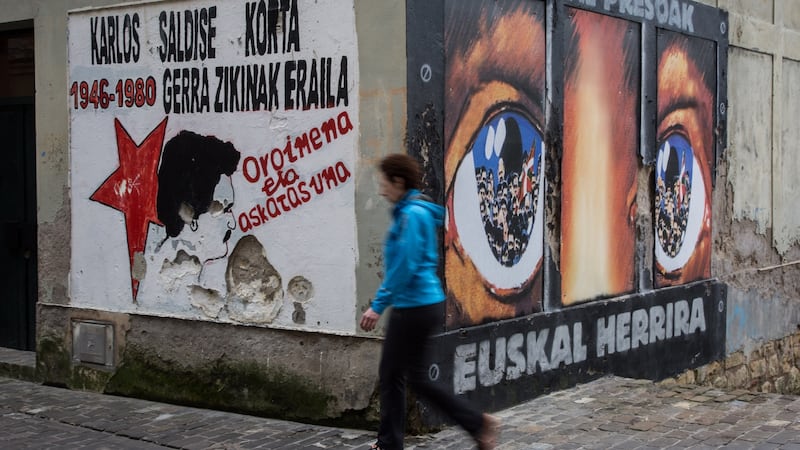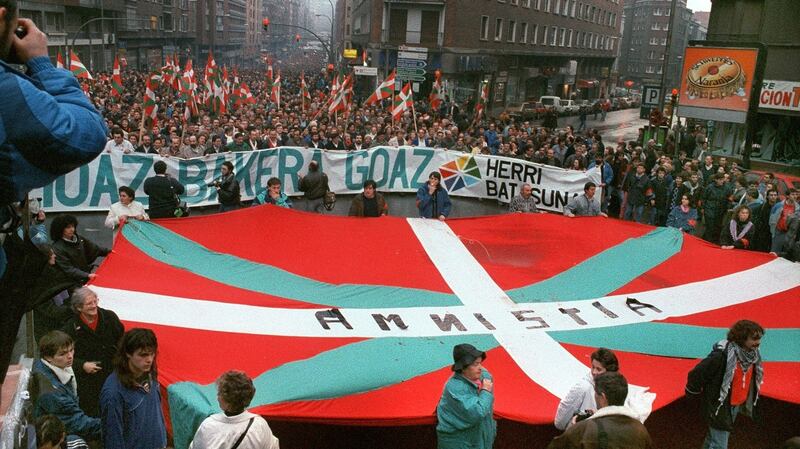"There's a great gap," Pegeen Mike reminds us in Synge's Playboy of the Western World, "between a gallous story and a dirty deed."
The tragic drama of Eta, the armed Basque nationalist group, will draw towards its final curtain on April 8th if, as the group has promised, it finally hands over its last weapons, making its dissolution almost inevitable. The drama's plot has veered repeatedly across a similar gap to that described in the Playboy, between heroism and brutality, depending on who you listen to, and what your values are.
For hardline conservatives, Eta was always simply a criminal terrorist gang. For a rapidly shrinking group of diehards, Eta’s revolutionary honour remains intact and unquestionable.
For most Basques, however, and for many democrats in Spain and farther afield, Eta's campaign for an independent Basque country, and Madrid's response, has evoked much more complex responses over the years. It's conveniently forgotten by many now, but Eta's bold defiance of the fascist military dictatorship of General Franco was, in the late 1960s and early 1970s, often compared to the impeccable anti-Nazi struggle of the French Résistance.
A family row
My own first clear recollection of Eta dates back to an argument with my father from that period, on December 20th, 1973, to be precise. Breakfast radio had just told us that Admiral Luis Carrero Blanco had been blown up by a tunnel bomb in the centre of Madrid.
I confess that I was almost elated by the news. Carrero Blanco, a man equally obsessed with the alleged threats of Jewish, Masonic and Marxist conspiracies, had been appointed Franco’s first prime minister, to ensure that the dictatorship outlasted the dictator. Even today, many sober historians accept that his assassination removed a key obstacle to Spain’s subsequent transition to democracy. With the treacherous clarity of youth, I welcomed the demise of such a monstrous figure.
My father gently chided me. He was no admirer of Franco, but he abhorred all violence. Even under a dictatorship, he insisted, there must be a better way to change things.

Having covered Eta for this newspaper for most of the next 45 years, I remain conflicted on the Carrero issue, but I understand my father’s position much better today. I still shed no tears for the admiral, but I gradually became aware of how actions like his assassination become mythologised into “gallous stories”. They form grim templates, to be re-enacted by successive generations of young warriors, to prove that their commitment to the cause is absolute.
For Eta, and the surprisingly broad Basque social milieu that sustained it until recent years, violence became fetishised as the only valid means to achieve independence and socialism, even after the dictatorship morphed into democracy. The unquestioned primacy of the pistol over politics in Eta became the group’s hallmark.
The contrast with the Irish republican movement, at least in recent decades, is important. Although significant Sinn Fein leaders retained roles and commanding authority within the IRA as the peace process got under way, Eta’s political front, Batasuna, long remained completely beholden to Eta figures in the shadows.
However, Eta started life in 1959 very differently, as an unarmed student study group. Its founders were frustrated by the failure of the Basque Nationalist Party, crushed by Franco in the 1936-39 civil war, to mobilise Basque society against his regime.
But the group was soon influenced by the armed leftist national liberation struggles in Algeria, Cuba and Vietnam, so idealised by many students at the time. It was also deeply affected by the worker priest movement in the strongly anti-Franco Basque Catholic Church.
Eta’s radicalisation and rapid growth was assisted, ironically enough, by the regime’s own actions. Even symbolic acts of resistance, such as displaying a Basque flag, could be met with a hail of bullets from trigger-happy security forces. Eta soon learned to attach booby-trap bombs to Basque flags. The group was a child of Franco, and continued to behave as such long after the dictator was dead.
Eta’s theory proves correct
As Eta’s interest shifted from lively discussions to live ammunition, it espoused a theory of “the spiral of action-repression-action”. This theory taught that an armed action against state forces would provoke widespread repression, affecting many people outside Eta’s own ranks. This would create popular sympathy, producing new recruits and a stronger organisation, capable of carrying out bigger armed actions. And so on and so on, spiralling ultimately into a victorious “people’s war”.
The dictatorship responded to Eta’s early attacks as though they had been trained in this theory themselves. States of emergency were imposed that treated the entire Basque population as enemies of the state. Support for Eta soared as more and more citizens were directly affected by indiscriminate police street brutality, mass arrests and torture. Eta’s dead were revered as martyrs.
But even then there were troubling ambiguities in the heroic narrative. Eta’s first proven victim was a young Guardia Civil, José Pardines. He was killed by a charismatic Eta leader and budding poet, Txabi Etxebarrieta, in 1968. Within 24 hours, the killer had been killed by the Guardia Civil. His funeral was thronged by supporters, and Eta recruitment mushroomed. The theory worked well from the outset.
However, many years later, his comrade in the action, Iñaki Sarasketa, alleged that Etxebarrieta was high on amphetamines at the time, and shot Pardines in cold blood while the latter was on the ground checking their car’s engine number. A gallous story or a dirty deed?
Franco’s last sting
I was plunged into this dark atmosphere when I arrived in Bilbao as an English teacher in September 1975. Franco lay dying, but he was still alive enough to sign death warrants for two young Eta activists (and three other leftist revolutionaries). The five were executed despite clemency pleas from the pope and the withdrawal of 13 ambassadors from Madrid.
"I have a German passport," he told the guardia sitting on top of him. "And I have a pistol," said the officer, and beat his face black and blue with the barrel
Franco died weeks later, but the dictatorship remained in place. There was turmoil all over Spain as pro-democracy rallies and strikes erupted, but the Basque Country was almost constantly on fire. Weekend after weekend, I witnessed the casual brutality of the police on the streets, every time half a dozen people tried to gather to demand democracy or independence.
A German colleague with no political sympathies was thrown into a Guardia Civil vehicle after he went for a peaceful Sunday stroll in Guernica, and found himself near a demonstration. “I have a German passport,” he told the guardia sitting on top of him. “And I have a pistol,” said the officer, and beat his face black and blue with the barrel.
The following year, King Juan Carlos began to encourage a tortuous, flawed but nonetheless real transition to democracy. Significantly, a new constitution, although popular in the rest of Spain, won only minority support among the Basque electorate in 1978. Then, two years later, a majority of Basques appeared to endorse this constitution retrospectively, by accepting very extensive powers of self-government under its provisions.
To the surprise of many observers, Eta did not respond by participating in the political process, despite an amnesty, but instead ratcheted up its violent attacks. It claimed less than 20 victims in the year Franco died, but almost 100 in 1980. More disturbingly still, this escalation cannot be attributed solely to a small group of fanatics. Eta’s political front, then called Herri Batasuna, took 16 per cent of the Basque vote the same year.

Why would so many decent people, most of them well employed and well-educated – the Basque Country has long been one of the most prosperous regions in Spain – lend their support to an avowedly Marxist and very violent organisation? Eta steadily extended its list of “legitimate targets” to noncombatants, and caused increasing numbers of civilian deaths in bombings, yet retained significant popular support for decades.
A difficult summary
I spent much of the next 25 years trying to explain this tragic phenomenon to readers of this newspaper, and wrote two books in the process. Compressing my conclusions into a few paragraphs is not easy, but here goes:
Firstly, Eta’s internal culture was intoxicated from the outset on an authoritarian triple cocktail. Its ideology fused narrow, blinkered nationalism, the absolute existential commitment extolled by some forms of radical Catholicism, and dogmatic Marxism.
Those who were not with Eta were categorised as enemies of the Basque people, even if they supported independence by peaceful means
Those who were not with Eta were categorised as enemies of the Basque people, even if they supported independence by peaceful means. Political violence was not a tactic, or even a strategy, but became a sacramental touchstone that defined authentic Basqueness. Real negotiation, which demands a willingness to concede points to the other side, was equated with betrayal of first principles. Politics was treachery.
But secondly, and perhaps equally critically, the Spanish establishment and their (many) Basque supporters have never understood or accepted the broad desire for self-determination in the region. Spanish democratic parties, at least on the left, had once supported a Basque right to self-determination, but dropped this demand very quickly during the transitional negotiations, leaving Basque nationalists feeling betrayed.

The terrible irony is that most Basques probably wanted, and want, to remain within the Spanish state, though under a federal arrangement. But many resent the fact that Madrid has never had, as they see it, the good manners to ask them whether they want to be part of the Spanish body politic. The outcome is a deep alienation from the Spanish state among many otherwise law-abiding Basques.
Thirdly, and related to the second point, Spanish democracy has been critically compromised by its continuation of many of the brutal methods of the dictatorship in its response to Eta. It is well documented that ministers in Felipe González’s centre-left 1980s government authorised an illegal “dirty war” that killed 27 people and injured dozens more. Many victims were unconnected to Eta.
A vengeful state
International human rights organisations have repeatedly established that the Spanish police forces have practised torture with impunity on Eta suspects at least until the 1990s. The Spanish judiciary remains to this day very politicised in Eta cases. Current policy on prisoner release, after more than six years’ total ceasefire, seems more influenced by vengeance than by justice.
Sadly, these abuses provided just enough evidence to persuade Eta’s supporters that Spanish democracy was a mere facade for a continued dictatorship, guaranteeing at least passive support for the group’s terrorism in significant sectors of the population for many years.
It was only after Eta’s failure to engage seriously in two attempted peace processes, in 1998-9 and 2006-7, that its support began to really fall away. Under these circumstances, the political leadership finally found the courage and the leverage to persuade the militarists to unilaterally stand down their campaign, already decisively weakened by police operations, without any concessions from Madrid.
Everyone who loves the Basque Country will welcome today’s disarmament initiative. Most Basques are more than ready to embrace a new narrative of peace and reconciliation, one that requires neither gallous stories nor dirty deeds, from their own community or from Madrid.
- Paddy Woodworth is the author of Dirty War, Clean Hands (Yale 2002) and The Basque Country (Oxford 2008)


















